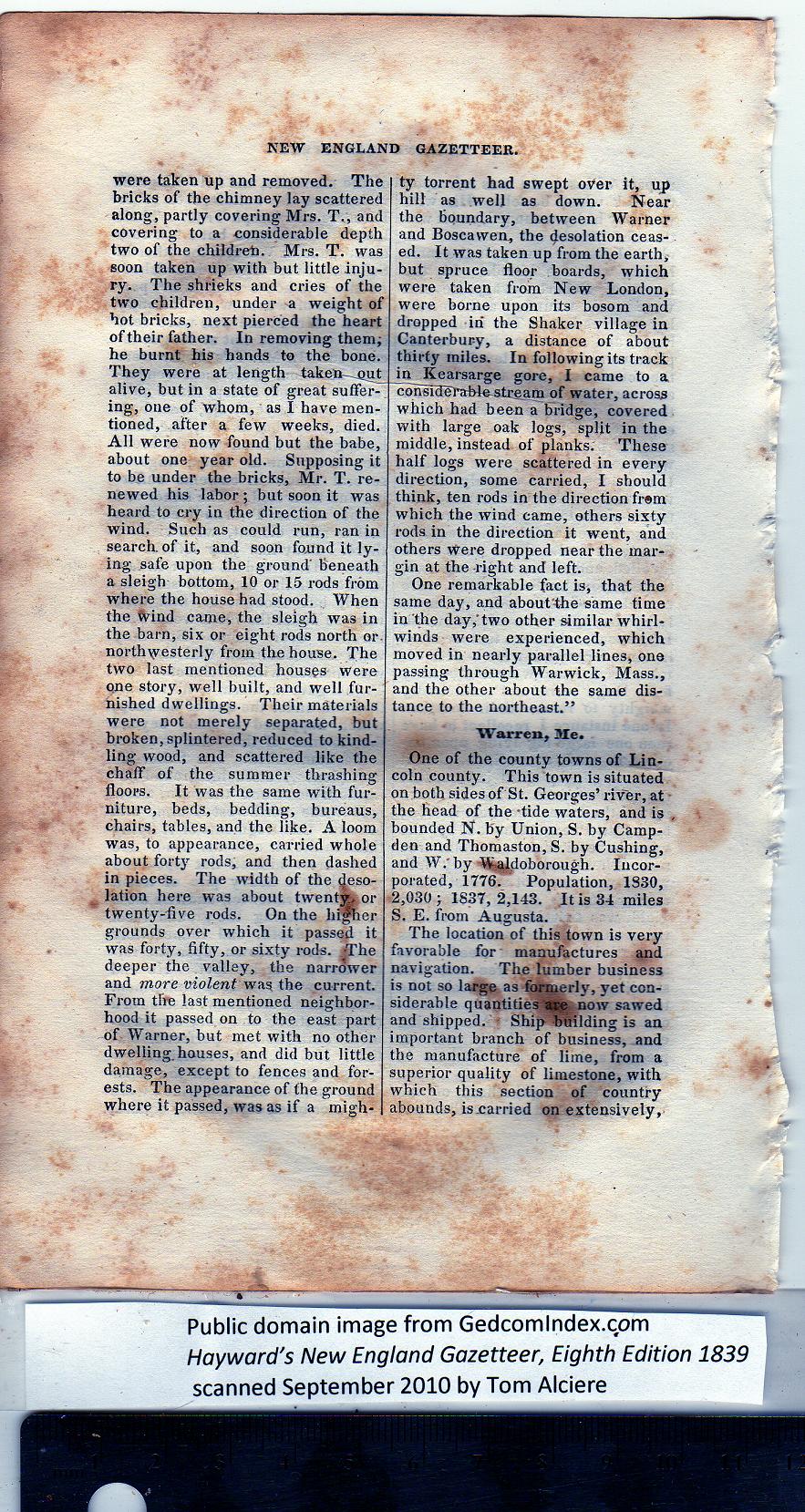|
were taken up and removed. The
bricks of the chimney lay scattered
along, partly covering Mrs. T., and
covering to a considerable depth
two of the children. Mrs. T. was
soon taken up with but little inju-
ry. The shrieks and cries of the
two children, under a weight of
hot bricks, next pierced the heart
of their father. In removing them;
he burnt his hands to the bone.
They were at length taken--o.ut_
alive, but in a state of great suffer-
ing, one of whom, as I have men-
tioned, after a few weeks, died.
All were now found but the babe,
about one year old. Supposing it
to be under the bricks, Mr. T. re-
newed his labor ; but soon it was
heard to cry in the direction of the
wind. Such as could run, ran in
search of it, and soon found it ly-
ing safe upon the ground' beneath
a sleigh bottom, 10 or 15 rods from
where the house had stood. When
the frind came, the sleigh was in
the barn, six or eight rods north or
northwesterly from the house. The
two last mentioned houses were
one story, well built, and well fur-
nished dwellings. Their materials
were not merely separated, but
broken, splintered, reduced to kind-
ling wood, and scattered like the
chaff of the summer thrashing
floors. It was the same with fur-
niture, beds, bedding, bureaus,
chairs, tables, and the like. A loom
was, to appearance, carried whole
about forty rods, and then dashed
in pieces. The width of the deso-
lation here was about twenty or
twenty-five rods. On the higher
grounds over which it passed it
was forty, fifty, or sixty rods. ^The
deeper the valley, the narrower
and more violent was the current.
From the last mentioned neighbor-
hood it passed on to the east part
of Warner, but met with no other
dwelling, houses, and did but little
damage, except to fences and for-
ests. The appearance of the ground
where it passed, was as if a migh-
ty torrent had swept over it, up
hill as well as down. Near
the Boundary, between Warner
and Boscawen, the desolation ceas-
ed. It was taken up from the earth,
but spruce floor boards, which
were taken from New London,
were borne upon its bosom and
dropped in the Shaker village in
Canterbury, a distance of about
thirty miles. In following its track
in Kearsarge gore, I came to a
^considerablestream of water, across
which had been a bridge, covered
with large oak logs, split in the
middle, instead of planks. These
half logs were scattered in every
direction, some carried, I should
think, ten rods in the direction from
which the wind came, others sixty
rods in the direction it went, and
others were dropped near the mar-
gin at the right and left. |
One remarkable fact is, that the
same day, and aboutthe same time
in the day,’two other similar whirl-
winds were experienced, which
moved in nearly parallel lines, one
passing through Warwick, Mass.,
and the other about the same dis-
tance to the northeast.”
Warren, Me.
One of the county towns of Lin-
coln county. This town is situated
on both sides of St. Georges’ river, at
the head of the -tide waters, and is ,
bounded N. by Union, S. by Camp-
den and Thomaston, S. by Cushing,
and W.'by Wgldoborough. Incor-
porated, 1776. Population, 1S30,
2,030 ; 1837, 2,143. It is 34 miles
S. E. from Augusta.
The location of this town is very
favorable for manufactures and
navigation. The lumber business
is not so large as foinnerlv. yet con-
siderable quantitie^Bjk-now sawed
and shipped. Shipbuilding is an
important branch of business, and
the manufacture of lime, from a
superior quality of limestone, with
which this section of country
abounds, is .carried on extensively, |
